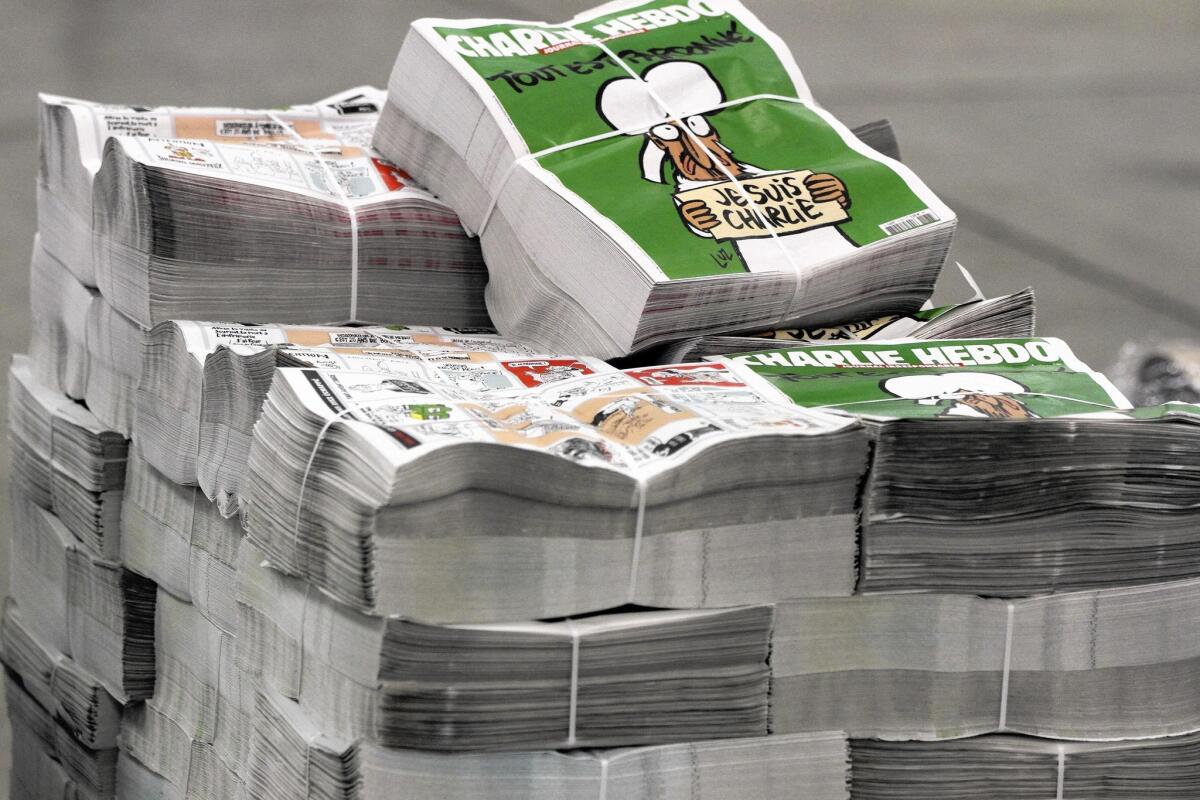Ridiculing of leaders through satire has a long history

More than a million people — including a camera-friendly rack of world leaders — took to the streets of Paris last weekend to march in support of free expression in the wake of the killing of cartoonists and others at the satirical magazine Charlie Hebdo by Islamist gunmen. But the nature of the paper’s cartoons, along with its new cover, which features a depiction of the prophet Muhammad bearing the sign “Je Suis Charlie,” has put the art of satire in the cultural crosshairs.
A range of thinkers including novelist Salman Rushdie and comics artist Art Spiegelman have defended the rights of the cartoonists, with some promptly adopting the “Je Suis Charlie” meme.
Many others have condemned the violence but remain critical of the magazine’s gleefully crude depictions of the prophet Muhammad. (Among some Muslims, it is considered blasphemous to render images of the prophet.)
And there is the question of the countless other sensationalistic drawings, one of which showed a black justice minister as a monkey and another that depicted girls kidnapped by Boko Haram militants in Nigeria as wailing welfare recipients.
“I see nothing heroic about a bunch of elite white writers and artists picking on the identities and beliefs of minorities,” Beirut-based culture writer Yazan Al-Saadi wrote in OpenDemocracy. “Satire is supposed to be an act that punches up to power, and not down to the weak.”
In some of the discussion surrounding the case, there has been an implication that Muslims (and other non-Westerners, for that matter) don’t have the rich satirical tradition found in places like France. That’s not quite true. Satirical traditions may not be the same in France as they are in Iraq or Venezuela. But the mocking of rulers, politicians and pretensions has long had a place in every culture.
All of this gets at the complicated nature of satire (especially in the Internet age, in which an image can travel the globe in seconds, stripped of all context). Simple answers can be difficult to find about an art form that is specifically designed to poke and prod at each society’s most time-honored taboos.
France, the country that gave rise to 19th century political cartoonist Honoré Daumier — who once portrayed French King Louis Philippe as an engorged ruler excreting political favors — has a strong tradition of gloves-off cartooning, along with other forms of literary and theatrical satire. The same goes for other Western democracies, such as England, where cartoonist Gerald Scarfe once depicted Tony Blair’s angry face emerging from George W. Bush’s posterior in a piece titled “In a Terrible Hole.”
U.S. satire, perhaps not as fierce, runs the historical gamut from Benjamin Franklin, who once wrote a sarcastic treatise about the British government titled “Rules by Which a Great Empire May Be Reduced to a Small One,” to the fake news items of the Onion, known for poking fun at government in headlines such as “First-Term Congressman Brings Fresh Roadblocks to Table.”
In authoritarian countries, where censorship is an issue, satire is often shaped by what is politically feasible. In Venezuela, that might take the form of online animation — on websites such as El Chigüere Bipolar (The Bipolar Capybara) — since the Internet evades the controls of state-controlled media. In Zimbabwe, satirical writers such as Silvanos Mudzvova stage impromptu street theater performance as a way of evading censors and the police.
Ease of dissemination can also be a factor in how satirical stories get told. A lot of satire in the Middle East has historically been literary, says Nahrain Al-Mousawi, a scholar of comparative literature who is based in Morocco, since it is cheap to produce and distribute.
“It does not require as much funding as painting, theater, film,” she writes via email. “From the medieval era, as well as before Islam, poets used satire as an instrument of ridicule.”
Alexander Key, a professor of Arabic and comparative literature at Stanford, says that this literary tradition is rich and varied and comes in the form of poetry and prose.
“In the 10th and 11th century, there was a figure called Abu Hayyan Al-Tawhidi [from Iraq],” he says. “He’s a court scholar, entertainer, source of wisdom. He writes a book that reflects his experiences called ‘The Moral of the Two Viziers’ [also sometimes translated as ‘The Character of the Two Viziers’]. And he goes to town on these rulers, accusing them of being incredibly stupid and deviant.”
In modern times, there have been countless other satirists in a variety of other media. Syrian artist Ali Farzat regularly took on corruption and the military in his political cartoons. The Pakistani weekly the Friday Times has regularly published fictitious satirical diaries — including one called “Mush and Bush,” an alleged conversation between General Pervez Musharraf and President George W. Bush.
And, from 2011 to 2013, Egyptian satirist Bassem Youssef hosted a television show known as Egypt’s answer to “The Daily Show,” in which he mocked religious fundamentalists, the ruling class and the Egyptian president. He is off the air since the current political climate has made it difficult to work.
Indeed, persecution is a running theme in the story of satire. Daumier was thrown in jail for his crass depictions of Louis Philippe. Danish cartoonist Kurt Westergaard has had several attempts on his life after publishing an illustration of the prophet Muhammad with a bomb on his head in the newspaper Jyllands-Post in 2005.
Farzat had his hands broken after creating a political cartoon that showed Syrian leader Bashar Assad in a bad light in 2011. Many others — including Argentine graphic novelist Hector Oesterheld and Palestinian political cartoonist Naji Salim Al-Ali — have been killed.
Indeed, an important part of the role of satire is to stomp at the margins of what is acceptable. Except, what’s acceptable will depend on where you are standing. In Japan, the royal family tends to be off-limits to satirists, whereas in places like England, it’s open season. In the U.S., the sexualizing of children is generally a no-go zone — as the Onion learned when it was forced to retract an obscene satirical tweet about child actress Quvenzhané Wallis. And, in the Middle East, religion and political leaders are generally off-limits.
One culture’s satire can easily be another’s offense. Which is why the debate surrounding the exact nature of the Charlie Hebdo cartoons is so tricky.
The magazine is known for going after France’s anti-immigrant far right with cartoons that lampoon that group’s xenophobic ideals. (Just as Stephen Colbert frequently lampooned the U.S. right wing by assuming a language of hyperbolic patriotism.) The image that depicted Boko Haram girls as welfare queens took two unrelated events in the news — the kidnapping of the girls and welfare cuts in France — and mashed them up into a parody that was intended to attack the far right’s retrograde views on both.
On their own, the images are appalling. Within the context of the publication’s mission, and the long and rowdy tradition of French political cartooning, they are satire. (And like a lot of satire, it isn’t pretty.)
But there is another French cultural context in which these cartoons exist.
In the wake of the killings, there’s been a lot of discussion about how this peculiarly French art form is being misunderstood abroad — in particular, the Middle East. But the pundits might do better to turn their gazes back to France where it appears that the crime’s perpetrators were principally born and raised.
France is a country where support for anti-immigrant parties is on the rise, where the wearing of head scarves has been regulated by the government, and where a Christian citizen is 21/2 times more likely to get called for a job interview than a Muslim one. In many ways, Charlie Hebdo embodied this inequity — with a largely white male editorial staff that seemed to take particular delight in making relentless satirical assaults on religion, especially Islam.
In this light, some of the cartoons can feel tone deaf, the powerful making a mockery of the disenfranchised.
Satire lives and dies by its context. The best satirists are the ones who realize when that context has changed.
More to Read
The biggest entertainment stories
Get our big stories about Hollywood, film, television, music, arts, culture and more right in your inbox as soon as they publish.
You may occasionally receive promotional content from the Los Angeles Times.











